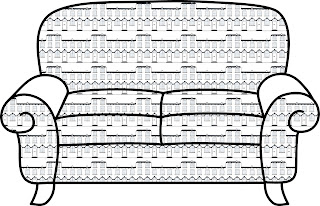While I had chosen early into this project to focus on a textile led product for the home, a big decision to make was what type of product that would be? Initially, I considered re-upholstering a secondhand sofa, playing with pattern placement, as seen in the image above.
However, after listening to feedback from the client, in this case, Saltaire Inspired, and considering the practical implications, I decided to work on home accessories such as cushions and lampshades. Given the time restraints and practicalities of sourcing and transporting a sofa compared with transporting, for example cushions, which would sit nicely on the existing bench at our designated location, this certainly made more sense.
Above: a prototype - how my design would work on a cushion
Another big decision, and for me probably the toughest decision, has been choosing the fabric for my products. With a focus on sustainability, I was keen to use natural fabrics, as well as secondhand or scrap materials where possible. At first, this led me to consider linen over cotton. I have previously written about my concerns with the cotton industry in countries such as China, which you can read about here, and linen is considered a zero-waste fabric since every part of the flax plant is used in the production of linen fibres (Fletcher, 2008).
Above: the semi-transparent nature of this gauzy 100% pure linen is not practical for my monochrome cushion design.
However, after checking my sample test print, see image above, it became clear that the semi-transparent nature of 100% pure linen would not work for my cushion design, particularly since my cushion fillers would be donated secondhand fillers and therefore a variety of colours!
This project has certainly opened my eyes to the issues involved in the complex textile industry. While cotton is problematic, both from an environmental angle, and ethically, as I previously discussed in my blog post on ethics, in the end, I opted for a cotton linen blend. According to the company I used to print my design, the fabric is both recycled and organic, which means no chemical fertilisers are used in the growing process. While this project has taught me to be cynical of claims, it has also shown me the challenges involved in checking every stage of the manufacturing process.
From a practical point of view, the cotton linen blend has a solid, opaque finish, which makes it great for printing on. It is also strong and durable, therefore suitable for home accessories and outdoor use; and with a plain weave, it works well with embroidery.
Above: a test sample of embroidered lavender on a cotton linen napkin.
To further increase the sustainability credentials of my cushions, I decided to create backs to the cushions from stitched fabric scrap off-cuts from a fabric retailer. I was fascinated by the life cycle of fabric 'scraps', as previously discussed in my blog post on Sustainability and how these can be recycled into fashion items and home accessories, which I researched in my Design and Trends Research. I used a mix of off-cuts and vintage napkins for the cushion backs, and for the cushion fillers, I used pre-loved cushion fillers that had seen better days and would have been thrown out anyway.
My embellishments would include vintage fabric scraps, dolls’ clothes, old twine, and tasseling, which was saved from the selvedge of a weaving project. I was particularly pleased about these aspects since I had read that “85% of clothing and textiles end up in a landfill, even though 95% can be reused and recycled” (Unknown, 2023).
Above: this lampshade destined for landfill has seen better days, but can it be put to good use?
Sources
Contrado.co.uk
Dunphy, N (2023) Design and Trends Research.
Fletcher, K (2008). Sustainable Fashion & Textiles. EarthscanInchyra.com
Inchyra.co.uk
Smith, A. (2009) The Sewing Book. Dorling Kindersley
(Unknown) (2023) Secondary Materials and Recycled Textiles (SMART) Available from: https://www.smartasn.org. Accessed 14th April 2023
Wisbrun,
L. (2011) The Complete Guide to Designing and Printing Fabric. A & C
Black Publishers Limited





Comments
Post a Comment